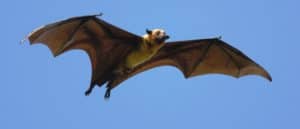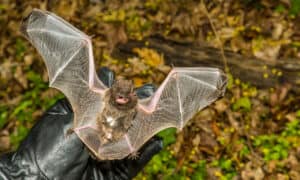Bats are a surprisingly diverse group of animals, ranging in size from teeny-tiny hognose bats the size of your fingertip to massive megabats with wingspans stretching five feet wide! The United States alone is home to nearly 50 unique species of bats, but here we’ll be focusing on the absolute largest varieties of the bunch. Read on to learn all about the United States’ five largest bats, just how big they get, and some interesting facts you should know about them.

1. Western Mastiff Bat (Eumops perotis)
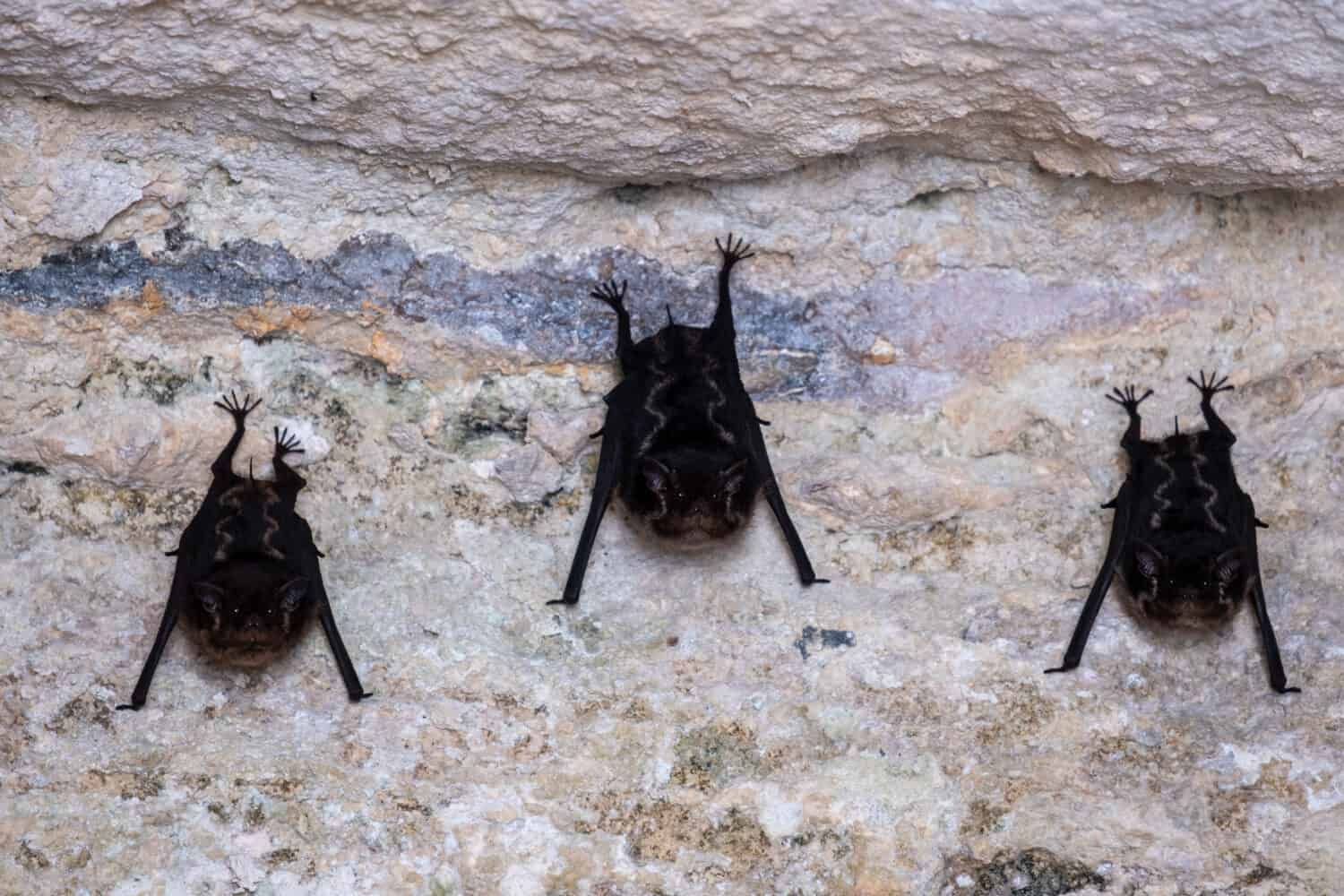
The Western mastiff bat’s geographic range extends from the American Southwest down to
Argentina
.
©LP Production/Shutterstock.com
America’s number-one largest bat species is the western mastiff bat, also known as the greater or bonneted mastiff bat. It’s also the largest bat species in North America as a whole!
The “mastiff” part of this species’ many common names comes from its uniquely–and adorably–dog-like face and rather short, upturned snout. Its large, wide ears extend forward over its snout. Each ear can measure 1.5 to nearly 2 inches long! Its body color, meanwhile, is generally a very dark, uniform brown or grayish brown, often with a slightly lighter underside.
Western mastiff bats range from around 6 to 7 inches long, and they boast a wingspan of 20 to 22 inches when fully mature. It typically weighs between 1.5 and 2.5 ounces. Interestingly, its long, narrow wings allow it to maintain high speeds for long periods while flying, but it isn’t quite as adept at turning or navigating narrow spaces.
As you might imagine, this particular bat prefers habitats with wide, open spaces rather than cramped caves. Flat, desert scrubs and woodland or grassland habitats without much tree cover are ideal. Its geographic range in the United States is mainly limited to the Southwest, particularly southern California, Arizona, Texas, and New Mexico.
Like most bats, the western mastiff bat is nocturnal. At night, it leaves its roost to search for small insects, most commonly moths. Unlike most bats, however, it does not hibernate or migrate in the winter but instead braves the chilly weather and stay fairly active year-round.
2. Florida Bonneted Bat (Eumops floridanus)

The Florida bonneted bat is North America’s second-largest bat and the largest species of bat in Florida.
©Usha Roy/Shutterstock.com
Up next on our list of the United States’ largest bats is the Florida bonneted bat, which was long classified as a subspecies of the Wagner’s bonneted bat. True to its common name, its geographic range is limited to south and central Florida. As one of North America’s most critically endangered species, it is protected by the Endangered Species Act of 1973.
As Florida’s largest bat, this species boasts a wingspan of around 20 inches when fully mature! It weighs between 1.5 and 2.3 ounces, while its body length reaches approximately 6 to 7 inches. Its fur is short and somewhat sleek and shiny, ranging in color from a pale grayish-brown to a more auburn-toned brown. Its ears are large for their size and sit facing forward on the head, giving it its distinctive “bonneted” look.
Similar to the western mastiff bat above, Florida bonneted bats are not migratory, nor do they hibernate. They live throughout southern Florida, and they prefer especially hot, humid areas with high amounts of rainfall. Its numbers have been on the decline since at least the 1960s. Climate change, rising sea levels, and habitat degradation from human activity have all contributed to its endangered status.
3. Hoary Bat (Lasiurus cinereus)
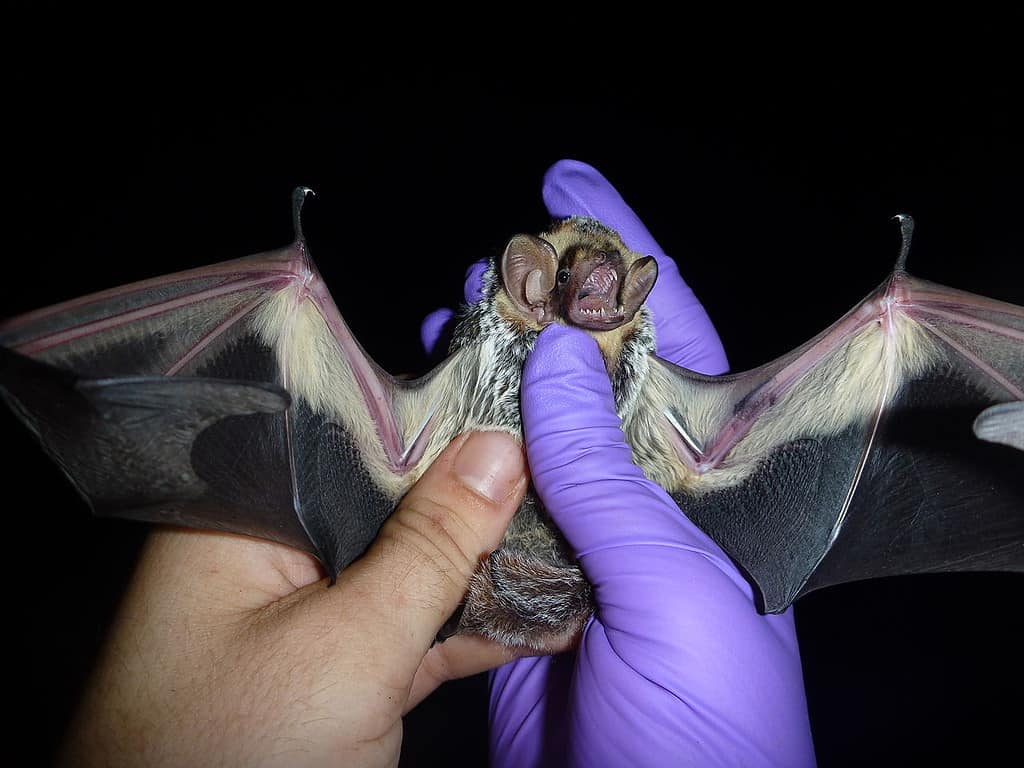
Hoary bats have short yet dense dark brown fur with white tips.
©Larisa Bishop-Boros / CC BY-SA 3.0, Wikimedia Commons – Original / License
The hoary bat gets its common name from its uniquely dark brown fur with striking white tips, giving it a “hoary” or grayish-white color. Notably, this species is the largest bat in Canada, and it’s also among the United States’ very largest bats. On average, fully mature specimens range from 5 to 5.5 inches long and weigh around one ounce. Their wingspan usually measures between 13 and 16 inches.
Hoary bats have a wide geographic range that stretches from northern Canada down through the majority of the United States, Central America, and parts of South America. They can be found as far south as Argentina and Chile. They often migrate long distances seasonally. During the chilly winter months, they migrate to warmer areas in Central and South America. When summertime rolls around, they travel north to the United States and Canada.
In terms of habitat preference, hoary bats most commonly reside in dense coniferous forests, where they roost amongst tall trees. They can cover impressive distances when foraging and feeding on insects, sometimes exceeding more than 20 miles in one hunt. Like many other nocturnal bats, its main prey is moths.
Fortunately, unlike the aforementioned Florida bonneted bat, hoary bats are not currently endangered or threatened. However, wind turbines are a major killer of hoary bats, likely because the bats are drawn to them, believing them to be potential roosts.
4. Big Free-Tailed Bat (Nyctinomops macrotis)
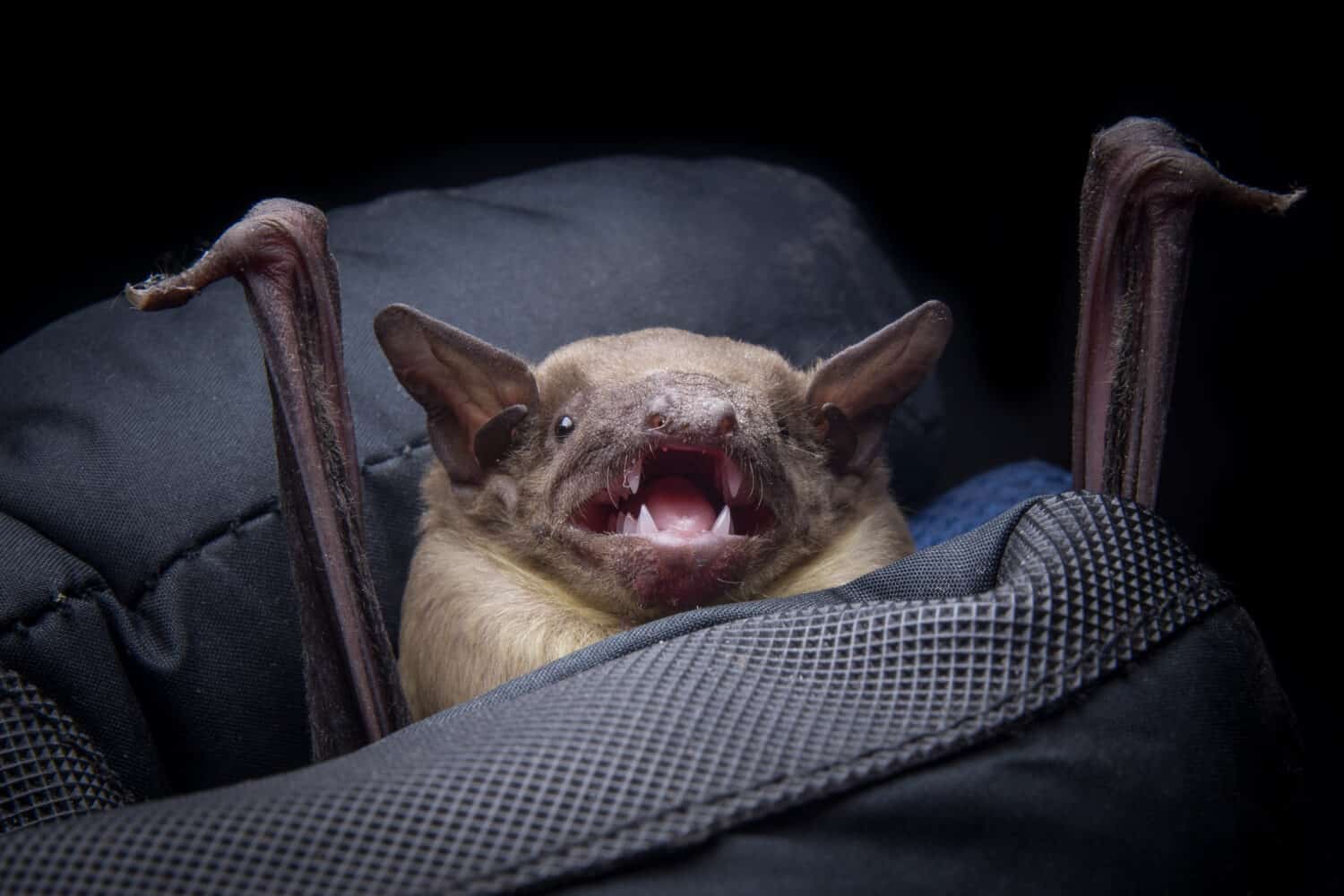
Big free-tailed bats are among the fastest bats on the planet, with an estimated 25-mile-per-hour flight speed.
©pemastockpic/Shutterstock.com
The next bat among the United States’ largest is the big free-tailed bat, which gets its common name from its long, thin, prominently free-hanging tail. Its wingspan ranges from 16 to 17 inches when fully mature. Meanwhile, its body length maxes out at around 5.5 to 6 inches, and it is fairly lightweight at just 20 to 30 grams on average despite its deceptively large appearance.
Thanks to this species’ uniquely long and lean body and an impressive wingspan, it is quite the high-speed flier! Researchers estimate its flight speed likely tops 25 miles per hour. Furthermore, the closely-related Brazilian free-tailed bat can zip through the night skies at speeds of up to 100 miles per hour. In general, free-tailed bats are among the speediest bats on the planet.
As you might have guessed for such a speedy animal, the big free-tailed bat has a wide geographic range that covers parts of North, Central, and South America. In the United States, it mainly lives in southwestern states like southern California, Arizona, and New Mexico. However, it has also been documented in other parts of the US, including parts of the Midwest and as far east as North and South Carolina. They’ve also been found as far north as southern Canada, though this is incredibly rare.
Big free-tailed bats are migratory animals that travel from Central and South America north to the southwestern United States every year. They can live in a wide range of habitats, from desert scrub to woodlands and even coastal plains, though they prefer rocky, dry regions.
5. Big Brown Bat (Eptesicus fuscus)

The big brown bat has a wide geographic range that covers much of North America, Central America, and parts of northern South America.
©Jay Ondreicka/Shutterstock.com
Last but not least, we come to the big brown bat, or the United States’ fifth-largest bat species overall. Despite its taxonomic status as a microbat, it is much larger than other microbats overall, with a wingspan of around 13 to 16 inches and a body length of around 4 to 4.5 inches. Its body weight is comparatively small at just 0.5 to 1 ounce.
Like most of the other varieties on our list, the big brown bat’s geographic range is quite vast. It resides as far north as southern Canada and as far south as parts of Colombia and Venezuela. Notably, it’s one of North America’s most widespread bats. It can thrive in a wide range of habitats, from dense forests to rocky, mountainous regions and even urban areas.
The big brown bat’s diet is insectivorous, with its preferred prey being flying insects like beetles and a wide range of flies. They’re major predators of several common agricultural pests, like shield bugs and scarab beetles. As a nocturnal animal, it hunts mainly at night, relying on echolocation to find prey, shelter, and other members of its species.
| Species | Wingspan | Body Length | Weight |
| 1. Western Mastiff Bat (Eumops perotis) | 20 – 23 inches | 6 – 7 inches | 1.5 – 2.5 ounces |
| 2. Florida Bonneted Bat (Eumops floridanus) | ~20 inches | 6 – 7 inches | 1.5 – 2.3 ounces |
| 3. Hoary Bat (Lasiurus cinereus) | 13 – 16 inches | 5 – 5.5 inches | 0.7 – 1.2 ounces |
| 4. Big Free-Tailed Bat (Nyctinomops macrotis) | 16 – 17 inches | 5 – 6 inches | 0.6 – 1.2 ounces |
| 5. Big Brown Bat (Eptesicus fuscus) | 13 – 16 inches | 4 – 4.5 inches | 0.1 – 1.0 ounces |
The photo featured at the top of this post is © Jay Ondreicka/Shutterstock.com
Thank you for reading! Have some feedback for us? Contact the AZ Animals editorial team.




